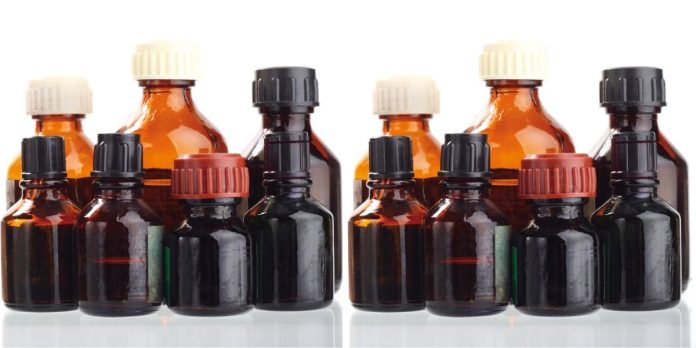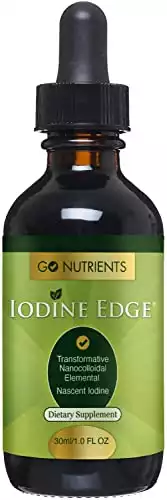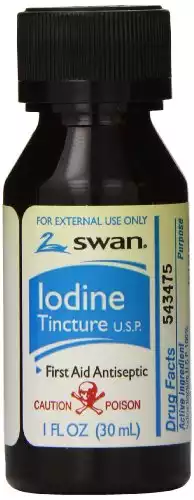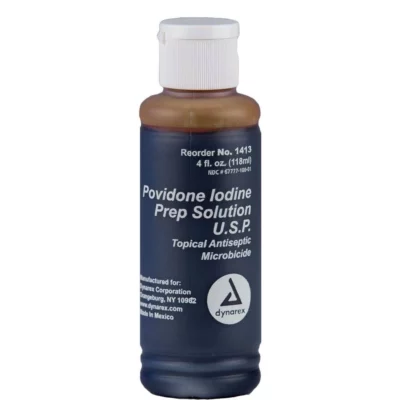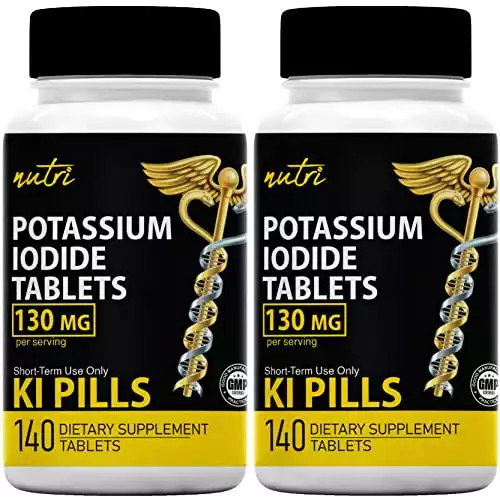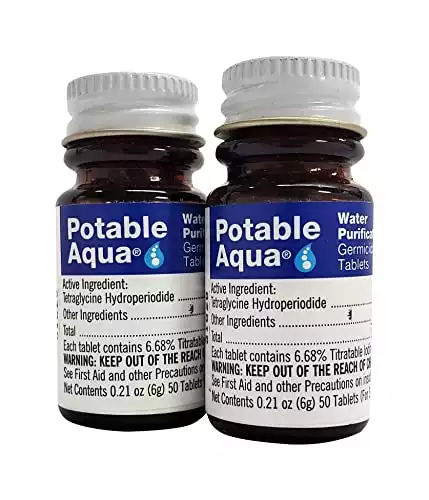Whether you’re thinking of the wound disinfectant, water purifier, or radioactive pill, many sources of iodine do expire eventually. Luckily, most can last anywhere from five years to indefinitely, depending on the form and how well you store it.
People often use the terms iodine and iodide interchangeably, but there are distinct differences between the various forms of iodine. We’ll clear up any confusion around the different types of iodine—and iodide—and provide the shelf life for each one.
Iodine, the Trace Element
Iodine (I) is a trace mineral found naturally in soil and certain foods. It’s also added to some foods according to FDA recommended dietary allowances.
Iodine is essential to the thyroid gland because it helps produce hormones that keep the body functioning properly.
The thyroid breaks down excess fat, controls body temperatures and proper growth, and improves fertility, muscle response, and heart rate. Lack of iodine in the body can lead to a number of complications:
- Neck swelling
- Weight gain
- Fatigue and weakness
- Hair loss
- Dry skin
- Reduced intellectual function
- Increased risk for attention deficit disorders
To avoid iodine deficiency, consider using iodine-rich foods for long-term storage. Salt is, by far, the easiest and most reliable way to store iodine for consumption. As long as you store it in a cool, dry place, salt lasts indefinitely.
As a backup to food storage, you can also use iodine solutions to avoid nutrient deficiencies. Just make sure you choose the right one.
But as you’ll see, getting essential nutrients to your body isn’t the only use for iodine.
Iodine Solutions
Iodine comes in a variety of aqueous solutions, and each one has its own distinctive purpose and shelf life.
From the mundane to the critical, people use iodine solutions for the following purposes:
Depending on your desired purpose, some forms work better than others.
Nascent Iodine (Iodine Solution)
Nascent iodine is an ideal high-energy supplement consisting of elemental iodine (often derived from food sources) and a solvent such as water, glycerin, or alcohol. It helps detoxify the body and support and build the immune system. It’s also a natural antiseptic and water purifier, making it one of the most popular iodine supplements on the market.
It’s sometimes referred to as “atomic iodine” or “atomidine.” Each manufacturer produces its own unique proprietary blend, but in all cases, the active ingredient is elemental iodine. This gives it an exceptionally high absorption rate, which may be why it’s the preferred choice over Lugol’s solution (discussed below).
There is some debate regarding the superiority of nascent iodine over other aqueous solutions. The argument is that the body absorbs nascent iodine better than any other form because of its natural state, but there is no evidence suggesting one is better than the other.
Manufacturers can mix iodine with either water, glycerin, or alcohol, so exact solutions vary. Thus, the shelf life of each nascent iodine product is slightly different. Alcohol solutions last substantially longer than those made with glycerin or water.
Generally speaking, water- and glycerin-based versions last five years. Alcohol forms can reportedly last upwards of 10 years, but there’s no official guidance on this, so it’s best to err on the side of caution and assume it’s at its best before five years is up.
Lugol’s Iodine (Potassium Iodide Solution)
Lugol’s solution is a mixture of iodine and potassium iodide. Its concentration ranges anywhere from 2% to 20%. People usually take Lugol’s iodine for an overactive thyroid, but you can also take it for radiation emergencies.
You can purchase Lugol’s 2% Solution over the counter just about anywhere. You can take the solution directly, but it’s better mixed with eight ounces of liquid or taken after meals to reduce the chance of an upset stomach.
As with nascent iodine, Lugol’s solution mixes with water, glycerin, or alcohol. Thus, the shelf life varies in the same fashion. The United States Nuclear Regulatory Commission (USNRC) does not provide any official expiration guidance for liquid solutions.
Therefore, the safest maximum shelf life would be five years.
Iodine Tinctures (USP 2%)
Many people prefer iodine tinctures as an antiseptic for wound treatment because it’s a clear solution and won’t stain your clothing or skin. It combines 2%–7% iodine mixed with potassium iodide, water, and alcohol.
You can typically find iodine tinctures in your medicine cabinet or first aid kit, and you can use them to treat wounds and disinfect water. Iodine tinctures kill bacteria and viruses but not protozoa.
According to Texas A&M, to purify water add 5–10 drops of iodine per quart of water and let sit for 30 minutes before drinking.
This form of iodine is not an effective nutritional supplement, so you should not take it orally for that purpose.
As for expiration dates, the International Program on Chemical Safety says,
“The shelf-life of iodine solutions vary with the concentration. The stability of alcoholic solutions of iodine increases as the iodide/free iodine ratio increases and for a given concentration, with increased strength of alcohol.”
So, like most tinctures, proper storage extends the shelf life, and alcohol bases last much longer than water or glycerin bases.
Povidone-Iodine (PVP-I)
Povidone-iodine is both more potent than iodine tinctures and highly toxic. It’s a mixture of povidone, elemental iodine, and hydrogen iodide. This is the traditional hospital iodine that’s been around since the 50s, and the one that surgeons generally use to prevent infections.
Equivalent to Betadine, povidone-iodine should never be used internally as a supplement or as protection against radioactive iodine.
While no studies show its effectiveness against virulent water-born pathogens, there is evidence suggesting that povidone-iodine is effective against E. Coli and traveler’s diarrhea.
Many manufacturers label povidone-iodine with a three-year expiration date. However, many seasoned chemists argue it does not expire, suggesting there’s a reason it is one of the oldest known antiseptics.
Iodine Tablets and Crystals Expiration
They wear a lot of different branding, but there are only two forms of solid “iodine” in the world of prepping: potassium iodide and tetraglycine hydroperiodide.
Potassium Iodide Tablets (KI)
Often referred to as “iodine pills,” potassium iodide tablets are your typical prepper’s nuke pills. In the event of a severe nuclear accident, potassium iodide is supposed to protect you from the effects of radioiodine.
Since the thyroid can only absorb so much iodine, the idea is that you fill it with potassium iodide so there’s no room for it to absorb the radioactive stuff. Officially, you should only take these under the guidance of local public health officials or emergency management.
There’s a common myth that potassium iodide is the wonder drug for a nuclear holocaust, but this isn’t the case at all. Potassium iodide is only useful for protecting the thyroid against radioactive iodine.
It does not protect other organs, nor does it protect you from radiation exposure in general. However, that’s not to say nuke pills aren’t worth having.
Of particular importance, these tablets are NOT the same iodine tablets used to purify water.
Potassium iodide tablets provide a stable shelf life of at least 10 years. In fact, the USNRC reveals that there is no “significant potential for chemical degradation” as long as the product is stored properly.
They outright state that it is safe to take KI tablets with an expired shelf life because “potassium iodide tablets are inherently stable and do not lose their effectiveness over time” with proper storage.
Potassium Iodide Crystals (KI)
Some preppers buy potassium iodide crystals to save money, but I’d suggest you have the knowledge and expertise to go with it. You can use them for both water purification and protection from radioactive iodine, assuming you know how.
Manufacturers assign different grades of purity (ASP, USP, NF, etc.) to crystalized solutions. Some are fit for human consumption, and some not so much. For example, potassium iodide crystals are very toxic. The wrong dosage could do more harm than good.
So, it’s best to stay away from potassium iodide crystals unless you know which forms are safe for human consumption. Otherwise, do your research before you buy.
That said, the expiration date for potassium iodide crystals is generally three years. Much like salt, however, as long as they remain dry and are stored properly, they have an indefinite shelf life.
Tetraglycine Hydroperiodide Tablets (Water Purification)
Survivalists often refer to “iodine tablets” as useful for water purification, but they’re really referring to tetraglycine hydroperiodide, an iodine compound containing 8 ppm iodine, or 8 mg of iodine per tablet.
These should not be confused with sodium dichloroisocyanurate, a type of water purification tablet that is not iodine based.
Tetraglycine hydroperiodide purifies water by killing certain bacteria, including giardia. However, it is not effective against cryptosporidium.
Officially, manufacturers stamp these water purification tablets with a 4–5-year expiration date. However, once you break the seal, they are good for only a few months. Unofficially, many preppers attest they have an indefinite shelf life as long as they remain in their original packaging.
In most cases, as iodine or iodide ages beyond its years, it never goes bad in the sense of becoming harmful when used properly. It merely degrades over time and becomes less effective.
However, in certain circumstances, less effectiveness could be dangerous. Ultimately, you must weigh the risks.

